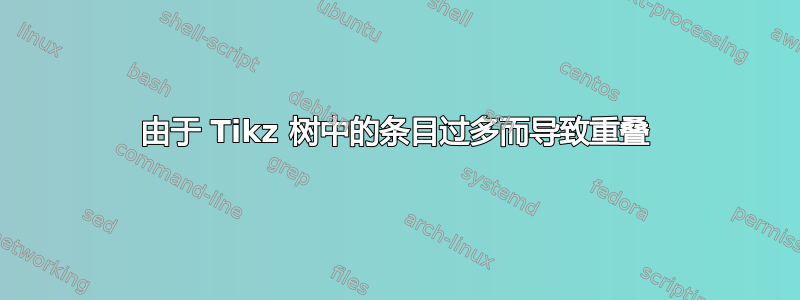
我想使用Tikz 树为了表示分类,我的问题是我有很多条目,所以它们重叠,如果我按照建议增加间距这里图形将超出边界,
你能告诉我如何解决这个问题吗?提前谢谢。
\documentclass{article}
\usepackage[utf8]{inputenc}
\usepackage{graphicx}
\usepackage{tikz}
\usetikzlibrary{trees}
\begin{document}
\begin{figure}[ht!]
\begin{tikzpicture}
[
level 1/.style = {red, sibling distance = 110mm, level distance = 8mm},
level 2/.style = {blue, sibling distance = 35mm, level distance = 10mm},
level 3/.style = {teal, sibling distance = 30mm, level distance = 12mm},
level 4/.style = {violet, sibling distance = 06mm, level distance = 30mm},
level 5/.style = {gray, sibling distance = 08mm, level distance = 30mm},
every node/.append style = {draw, align=center},
grow=right,
edge from parent path={(\tikzparentnode\tikzparentanchor) |- (\tikzchildnode\tikzchildanchor)},
]
\node {\textbf{Human Variability}}
%
child { node {Cognitive}
%%
child {node {individual}
%%-%
child {node {intra-personal}
child { node {Situation Awareness}}
child { node {Attention}}
child { node {Motivation}}
}
child {node {inter-personal}
%%-%%
child {node {Cognitive Load}
%%-%%-%
child {node {Comprehension}}
child {node {Mental Capacity}}
}
child { node {Experience}}
child { node {Satisfaction}}
child { node {Trust}}
child { node {Curiosity}}
child { node {Frustration}}
child { node {Acceptability}}
child { node {Usability}}
child { node {Task Engagement}}
}
}
child {node {Temporal}
%%-%
child {node {Volatile}
%%-%%
child { node {Curiosity}}
child { node {Situation Awareness}}
child { node {Attention}}
child { node[anchor=north]{Trust}}
child { node {Frustration}}
child { node {Task Engagement}}
child { node {Motivation}}
}
child {node {Consistent}
%%-%
child {node {Cognitive Load}
%%-%%
child {node {Comprehension}}
child {node {Mental Capacity}}
}
child { node {Experience}}
child { node [anchor=north]{Satisfaction}}
child { node {Acceptability}}
child { node {Usability}}
}
}
}
child {node {Physical}
%%
child {node {individual}
%%-%
child {node {intra-personal}
%%-%%
child {node [anchor= north]{Motor Variability}
%%-%%-%
child {node {Motion Trajectory}}
child {node [anchor= north]{Posture}}
child {node {Torque and Force}}
}
child {node [anchor=north]{Muscular Fatigue}}
child{node{Heart Rate Variability (HRV)}}
}
child {node {inter-personal}
%%-%%
child {node [anchor= north]{laterality (dominant hand)}}
}
}
child {node {Temporal}
%%-%
child {node {Volatile}
%%-%%
child { node {Motor Variability}
%%-%%-%
child {node {Motion Trajectory}}
child {node [anchor=north]{Posture}}
child {node {Torque and Force}}
}
child{node{Heart Rate Variability (HRV)}}
}
child {node {Consistent}
%%-%%
child {node [anchor=north]{laterality (dominant hand)}}
child{ node{Anthropometric Variability}
%%-%%-%
child {node {Body Dimensions}}
child {node [anchor=north]{Gender}}
child {node {Age}}
}
}
}
}
;
\end{tikzpicture}
\caption{Human Variability Classification}
\label{fig:HVC}
\end{figure}
\end{document}
答案1
这是一个使用 的解决方案forest,它的语法稍微简单一些,并且可以有效地分配节点而不会使它们重叠。该forked edges选项使用edges库。
有两个稍微复杂的部分:首先,为了使节点按级别对齐,使用tier/.pgfmath=level(),这是手册(版本 2.1.5)第 74 页隐藏的一个技巧。
parent anchor=center其次,在前几层将边缘绘制到节点中心( )允许负片l sep,这样各层就可以在维度上重叠x,但随后边缘将绘制在文本之上。为了解决这个问题,我重新定义了内置的draw tree edge/.code,将所有边缘放在背景层上。
以下是代码:
\documentclass{article}
\usepackage[edges]{forest}
\pgfdeclarelayer{background}
\pgfsetlayers{background, main}
\makeatletter
\forestset{draw tree edge/.code={\begin{pgfonlayer}{background}\forest@draw@edge\end{pgfonlayer}}}
\makeatother
\begin{document}
\begin{figure}[ht!]
\begin{forest}
for tree={grow=east, draw, forked edges,
l sep=1pt, anchor=base, s sep=1pt,
tier/.pgfmath=level(),
if level=1{red, edge=red}{if level=2{blue, edge=blue}{if level=3{teal, edge=teal}{if level=4{violet, edge=violet}{if level=5{gray, edge=gray}{}}}}},
fill=white, font=\small
}
[Human Variability, l sep=-1cm, parent anchor=center
[Cognitive, l sep=-5mm, parent anchor=center
[individual, l sep=-5mm, parent anchor=center
[intra-personal
[Situation Awareness]
[Attention]
[Motivation]
]
[inter-personal
[Cognitive Load
[Comprehension]
[Mental Capacity]
]
[Experience]
[Satisfaction]
[Trust]
[Curiosity]
[Frustration]
[Acceptability]
[Usability]
[Task Engagement]
]
]
[Temporal, l sep=-5mm, parent anchor=center
[Volatile
[Curiosity]
[Situation Awareness]
[Attention]
[Trust]
[Frustration]
[Task Engagement]
[Motivation]
]
[Consistent
[Cognitive Load
[Comprehension]
[Mental Capacity]
]
[Experience]
[Satisfaction]
[Acceptability]
[Usability]
]
]
]
[Physical, l sep=-5mm, parent anchor=center
[individual, l sep=-5mm, parent anchor=center
[intra-personal
[Motor Variability
[Motion Trajectory]
[Posture]
[Torque and Force]
]
[Muscular Fatigue]
[Heart Rate Variability (HRV)]
]
[inter-personal
[laterality (dominant hand)]
]
]
[Temporal, l sep=-5mm, parent anchor=center
[Volatile
[Motor Variability
[Motion Trajectory]
[Posture]
[Torque and Force]
]
[Heart Rate Variability (HRV)]
]
[Consistent
[laterality (dominant hand)]
[Anthropometric Variability
[Body Dimensions]
[Gender]
[Age]
]
]
]
]
]
\end{forest}
\caption{Human Variability Classification}
\label{fig:HVC}
\end{figure}
\end{document}




